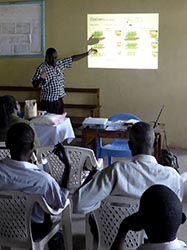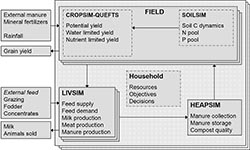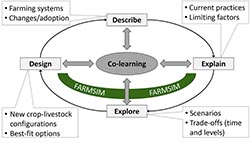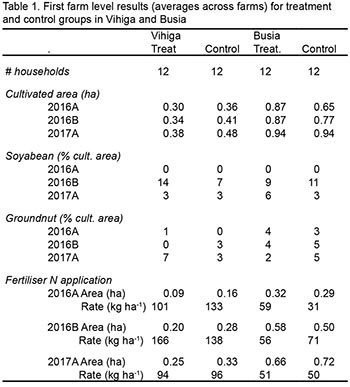| A PhD project using farming systems analysis in Kenya and Uganda My PhD research does not solely focus on legumes, but uses legumes as one of the options to sustainably increase farm-level production. The first field activities (and my PhD project) started in August 2016 with co-learning workshops in western Kenya and activities in western Uganda will follow early 2018. I am not completely new to N2Africa as I did both my MSc-theses within the project and also worked as a research fellow for N2Africa in the year before the start of my PhD. Here I will introduce how my PhD project uses methods of farming systems analysis – using NUANCES-FARMSIM in co-learning cycles – to assess how legumes and other options can contribute to a sustainable increase in production, and I will show some first results. |

|
|
NUANCES-FARMSIM as a tool for co-learning NUANCES-FARMSIM is a crop-livestock model with a user-friendly interface. It can simulate the complex interactions at farm-level and assess short-term yields and longer-term (10-15 years) trends in productivity and soil fertility (Figure 1). The decision space of smallholder farmers also depends on factors like availability and affordability of technologies and for instance cultural norms: factors that are difficult to model. Iterative cycles of co-learning in participatory modelling exercises with farmers and researchers can help to understand the decision space of farmers. Scenario outputs of NUANCES-FARMSIM for farms with different socio-economic characteristics, e.g. farm types, can facilitate these sessions and inform decision-making of smallholder farmers. |

|
First co-learning cycles in western Kenya
Two contrasting locations (in terms of agro-ecological conditions and market access) in maize-based systems in western Kenya were selected: Vihiga and Busia. Two sub-locations (treatment and control group) were selected with each 12 farmers (of 3 farm types). Farmers of both groups receive a voucher of USD 100 each season for which they can buy selected maize, soyabean, groundnut (from the 2nd season onwards), bush bean, and/or dairy inputs. The treatment group takes part in a co-learning workshops each season, whereas the control group does not take part in workshops.
|
Each season the research uses co-learning as part of a full DEED cycle (Figure 2.), using the following steps:
|

|
| Some results First results showed an unexpected increase in cultivated area (Table 1). Soyabean cultivation and fertilizer application also increased as a result of the increased accessibility due to the voucher and inputs brought in the workshops. Groundnut was only included in the voucher in the second season (2017A) and was liked as an alternative option for soyabean in Vihiga. Fertilizer application rates became more moderate in the second season due to an increase in the area it was applied on (discussed in the workshops). Differences between groups are expected to appear in coming seasons. |
 |
Future cycles: exploring farm level trade-offs:
- Long-term vs. short term benefits;
- Optimization of land allocation (i.e. maize vs. soyabean vs. Napier grass);
- Transformations towards higher production levels and more sustainable farming systems;
- Starting a similar series of co-learning cycles in banana-based systems in western Uganda.
Wytze Marinus, Wageningen University & Research, The Netherlands
References:
Descheemaeker et al., (2016). Climate change adaptation and mitigation in smallholder crop–livestock systems in sub-Saharan Africa: a call for integrated impact assessments, Exp Agric 1–22;
Van Wijk et al, 2009. Identifying key entry-points for strategic management of smallholder farming systems in sub-Saharan Africa using the dynamic farm-scale simulation model NUANCES-FARMSIM. Agric Syst 102, 89–101.
